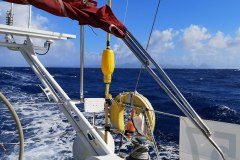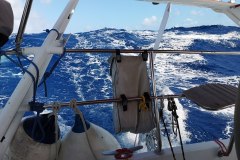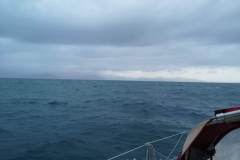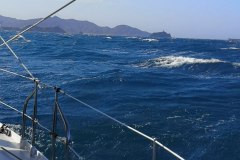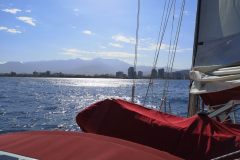On 11th January, the gun sounded, we crossed the line, and set sail for Santa Marta, Colombia. The initial course took us down the west coast of St Lucia, rounding a mark, and then heading direct to Santa Marta. Even within the lee of the island it was fairly windy, and we had to shorten sail even more as we reached the mark and saw a squall approaching. As we headed further west out of the wind shadow the wind increased up to about 25 knots; throughout the entire leg the wind never dropped below this. It was above 30 knots, with some line squalls to about 45 knots. We steered using the Wind Pilot which has two big advantages; no-one needs to helm, and it doesn’t need any power. The slight disadvantage was that it would steer us slightly to windward, about one mile to windward for every ten downwind.
The three of us stood night watches by ourselves, with three hours on watch. The watches ran from 9pm to 6am. In European waters, 3am to 6am is usually quite rewarding as you get to see the sun rise. In the tropics, sunrise was about 6:45am, so even this watch was in darkness. Time on watch was spent reading, watching the stars, and keeping an eye out for line squalls.
Line squalls are a hazard of sailing in the tropics. During the day it is easy to see a line of clouds approaching and if you are near any one cloud you can expect a sudden increase in wind speed (we recorded 45 knots at times), possibly pouring rain, and then it is over as quickly as it arrived. At night, if the stars vanished it was time to turn on the radar, watch the direction of the clouds, and call for help to decrease sail if a squall was going to hit. Bizarrely, several times during the day we watched a squall go past a few hundred metres from the boat with wind and rain while we sailed on completely unaffected.
Kate did an excellent job of preparing lunch and dinner (stored in a “Mr D’s thermal cooker”) to minimise time spent below until we got our sea legs. I spent the first night feeling a bit queasy, but the excellent Joy-Rides Travel Sickness tablets stopped the nausea, and I was able to dispense with the tablets during the second day.
We started the first day under main, with the genoa goose-winged. The second day saw us drop the main and put up a staysail to port, with the genoa poled out to starboard. This allowed us to point more downwind than we had managed on the first day. The waves had now built up to about 3-4 metres and we were regularly surfing down waves, helped by raising the keel, thus turning Barracuda into a planing dinghy!
To control the sails, we had about 16 different sheets rigged. Each day we had a full topsides inspection, checking sheets for any chaffing, inspecting the rigging, and tightening any bolts on the wind pilot which might have worked loose.
We saw the mountains of South America appear, and as the wind had dropped, we went back to full mainsail, along with the poled out genoa in order to catch (we hoped) the boat ahead of us. We had been warned about the strong winds off Santa Marta, and as we approached the wind started to increase; we crossed the finish line on 16th January with three reefs in the main and a few feet of genoa.
It was even very windy in the marina, leading to challenging berthing conditions, with several people on the pontoon and a RIB to help us dock. (This wind didn’t drop for the first two days we were there, leaving a fine layer of sand everywhere below.)
We arrived to hear the music blasting out from the beach next door; it was still holiday time in Colombia, and the partying continued all day and into the night.
The wildlife that we saw was fairly limited; a few pilot whales, lots of dolphins, and every morning dead flying fish on the deck. There was the occasional bird sighting.
Some film of Barracuda surfing the waves:


